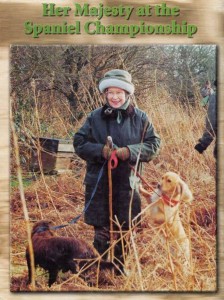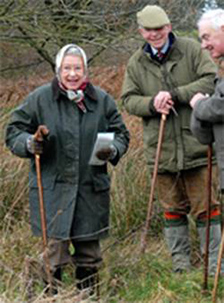Delivery to Hand
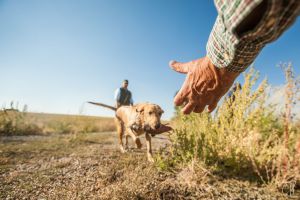
The skill of bringing a bird back, preferably uneaten, delivering it to hand, is a core expectation for any well-trained retriever.

Photo by Chris Dickinson
Mouthing a bird, plucking feathers, repeatedly dropping the bird on the return, blinking (refusing to pick up the bird momentarily) or running about, frolicking with the bird are all behaviors indicative of a dog inadequately trained for delivery to hand.
Developing natural delivery to hand is not difficult with patience and following the structure of the Wildrose Way of hold conditioning without the use of force-fetch techniques. These steps are clearly described in our training book, Sporting Dogs and Retriever Training, the Wildrose Way (www.wildrosetradingcompany.com) and on our Basic Gundog Training DVD. Our discussion in this issue centers on how to avoid problems associated with poor delivers. “An ounce of prevention” so to speak!
Contributors to Poor Delivery
1. Obviously allowing young dogs or pups to play with bumpers or birds is out of the question. Chew toys, fiber bones, chewing balls or any non-consumable item that may promote mouthing should be avoided. Remember, your pup is always in training. Think about what’s being reinforced.
2. The antiquated practice of providing the dog with body parts of birds (heads, intestines, slivers of flesh, wings) as a reward and to build birdiness should not be adopted if you expect clean delivery of an undamaged bird.
3. Hunting a pup too early and allowing him/her to encounter fresh game in an uncontrolled environment provides too many opportunities for things to go wrong with too little potential benefit. Live birds may intimidate the pup. The pup gets overstimulated and excited resulting in mouthing, plucking, frolicking or even consuming a small bird like a dove or quail. The young dog’s exposure to birds should occur after hold conditioning and in a controlled situation. No hunting prior to 12 to 14 months of age and before completing an entire basic gundog training program. Wildrose Law #4: Don’t condition in a problem that must be trained out later.
4. In training, randomly incorporate feather-laced bumpers to introduce feathers. If the pup blinks or picks the feathers, discontinue the lesson and return to plain firehose or canvas bumpers. Wait until the hold process is complete to revisit introducing feathers. (Note: Feathered bumpers and cold game are included in the hold conditioning process).
5. Never chase a pup with an object in his mouth. The practice will promote possessiveness and awaken dysfunctional prey instincts. If a pup initiates a game of keep away on a retrieve, quietly walk away (low stimulus) and call the pup to heel. The human tendency is to loudly yell commands that will be ignored and move toward the youngster… wrong! That will surely be perceived as “game on” and the adolescent will win.
6. If a pup persists on mouthing smaller training bumpers, do not continue the lessons. Think about what you are conditioning. Repeating any behavior with a dog can result in entrenching that very behavior to the point of habit, good or bad. If signs of mouthing present themselves:
A. Use canvas or firehose bumpers. Avoid plastic.
B. Enlarge the size of the bumpers.
C. Remove feathers.
D. Avoid small balls commonly used in training.
E. Do not expose the dog to cold game until the problem is corrected.
F. Large bumpers or deadfowl training dummies can be used in deep water. In some cases the dog swimming reduces their tendency to chew.
G. Reduce stimuli in training.
7. As mentioned, mouthing and dropping can be a result of too much stimuli in training promoting over excitement, competitiveness, or impatience. To correct delivery problems, slow the training sessions. Work alone with no other dogs about. Pace the tempo of the sessions and don’t repeat failures. Revisit a known behavior where success may be achieved. Simplify and repeat success.
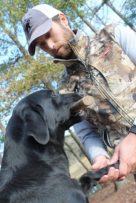
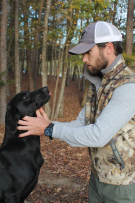
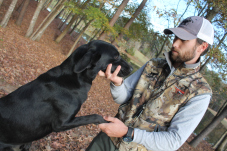
A. Do not begin hold conditioning too early. The youngster should have all adult teeth in, be enthusiastic about retrieving and be mentally developed to the point of understanding the process. That puts the dog at 7 months plus. At Wildrose we are usually working on hold when the dog is about 8 months of age. Make a mistake at this point and our prospect could lose interest and enthusiasm in picking anything up. The restart then becomes a challenge. We want to see a passion for the retrieve before the hold process begins.
B. If there is a problem in delivery before this point in the pup’s progression, stop retrieving. Don’t reinforce a problem. When working on retrieves with a young pup, do not allow them to drop at delivery. Get the bumper in hand. Sitting and presenting the bumper to hand will be developed later during hold conditioning.
C. Once hold begins, stop all retrieving until the process is complete.
D. Do not skip steps in the process. Once the sequence begins, complete every step. Don’t just “assume” that the skill is mastered
8. After hold conditioning, use only medium-size, clean birds. Avoid dove and quail—too small. Geese, rooster pheasants or large mallards—too large. The best birds for beginners:
A. Pigeon
B. Teal
C. Wood duck
D. Diver ducks
E. Spoonbill ducks
F. Chukkar partridge
G. Hen pheasant
There will be time for the big birds. Initially, we want to condition in a fast, clean pick of the bird and a prompt return without dropping. Remember Wildrose Law #5 – Make haste slowly.


